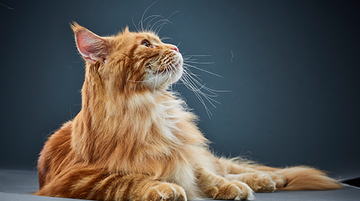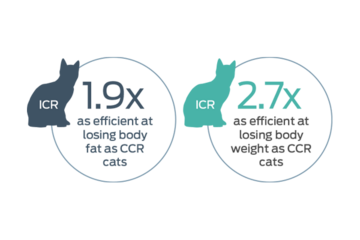The Science Behind Caloric Restriction


The “traditional” approach to weight loss is constant caloric restriction (CCR). However, this may not be the optimal way for pets—or people—to lose weight.1-3
In cats, for example, CCR has been shown to lower both lean body mass and energy expenditure.4-6 This lowered energy expenditure means that the body may become more efficient at utilizing fewer calories and storing the rest away as fat.
Dogs, like people, can also experience a weight rebound following caloric restriction that may be greater after severe caloric restriction.7
Intermittent caloric restriction (ICR) is an innovative weight loss method involving alternating periods of restricted and non-restricted eating. Beyond weight loss, studies show that this approach may yield metabolic benefits that help pets lead healthier lives.
Purina's research

Purina scientists compared the effects of ICR to CCR on weight loss in overweight cats. Based on equal caloric restriction, they found ICR was more effective than the CCR in promoting loss of body fat and percentage of body fat.8

Cats from ages 2 - 12 years that had become obese or overweight naturally were recruited into the study. For six months, cats in the CCR group were fed 75% of their maintenance energy requirement (MER). For 12 months, cats in the ICR group were alternatively offered 75% of their MER for two weeks.
While cats in both groups lost comparable amounts of weight and maintained lean body mass, there were significant differences:
- ICR cats were 2.7 times as efficient at losing body weight as CCR cats.
- ICR cats were 1.9 times as efficient at losing body fat as CCR cats.
- ICR cats had significantly higher MER than the CCR cats at the end of the study.
- ICR cats had significantly higher activity levels than CCR cats, possibly contributing to increased efficiency of weight and fat loss.
Key things to remember
- Obesity is a disease of global significance and is the most common form of malnutrition encountered by veterinarians.
- ICR has been shown to be more effective than CCR for promoting body fat loss and preserving more lean body mass.
- An intermittent caloric restriction approach may yield metabolic benefits, beyond weight loss, that helps pets lead healthier lives.
Find out more
-
Butterwick, R.F., & Hawthorne, A.J. (1998). Advances in dietary management of obesity in dogs and cats. Journal of Nutrition, 128, 2771S-2775S.
-
Varady, K.A. (2011). Intermittent versus daily calorie restriction: Which diet regimen is effective for weight loss? Obesity Reviews, 12, e593-e601.
-
Keogh, J.B., Pedersen, E., Petersen, K.S., & Clifton, P.M. (2014). Effects of intermittent compared to continuous energy restriction on short-term weight loss and long-term weight loss maintenance. Clinical Obesity, 4(3), 150-156. doi: 10.1111/cob.12052
-
Butterwick, R.F., Watson, T.D.G., & Markwell, P.J. (1995). The effect of different levels of energy restriction on body weight and composition in obese cats. Journal of Veterinary Internal Medicine, 9, 138.
-
Butterwick, R.F., & Markwell, P.J. (1996). Body composition changes in cats during weight reduction by controlled caloric restriction. Veterinary Record, 138, 354-357.
-
Villaverde, C., Ramsey, J.J., Green, A.S., Asami, D.K., Yoo, S., & Fascetti, A.J. (2008). Energy restriction results in a mass-adjusted decrease in energy expenditure in cats that is maintained after weight regain. Journal of Nutrition, 138(5), 856-860.
-
Laflamme, D.P., & Kuhlman, G. (1995). The effect of weight loss regimen on subsequent weight maintenance in dogs. Nutrition Research, 15(7), 1019-1028.
-
Pan, Y.L. (2015). Intermittent caloric restriction: A new way to feed cats for weight loss. Nestlé Purina Companion Animal Nutrition Summit, Barcelona, Spain, 61-66.
